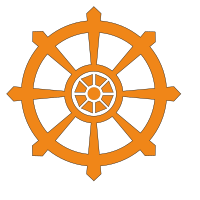佛教:修订间差异
Yuriy kosygin(留言 | 贡献) |
Yuriy kosygin(留言 | 贡献) |
||
| 第28行: | 第28行: | ||
<!-- Do not change this list without discussion on the Talk page --> |
<!-- Do not change this list without discussion on the Talk page --> |
||
[[Image:Takstan-monastery.jpg|thumb|250px|位於[[不丹]][[帕羅]]的塔克桑寺]] |
[[Image:Takstan-monastery.jpg|thumb|250px|位於[[不丹]][[帕羅]]的塔克桑寺]] |
||
*'''[[菩提伽耶]]''',位於[[印度]][[比哈爾]] — |
*'''[[菩提伽耶]]''',位於[[印度]][[比哈爾]] — 釋迦牟尼佛悟道的地方。 |
||
*'''[[布達納特|布達納特佛塔]]''',位於[[尼泊爾]][[布達納特]] — |
*'''[[布達納特|布達納特佛塔]]''',位於[[尼泊爾]][[布達納特]] — 佛教徒的神聖遺址。 |
||
*'''[[布姆唐宗|布姆塘河谷]]''',位於[[不丹]] — |
*'''[[布姆唐宗|布姆塘河谷]]''',位於[[不丹]] — 該河谷被認為是不丹的精神之心,包含許多神聖的遺址,包括[[賈卡爾]]著名的古杰寺。 |
||
*'''[[埃洛拉]]'''與'''[[阿旃陀]]''',位於[[印度]][[馬哈拉施特拉]] — |
*'''[[埃洛拉]]'''與'''[[阿旃陀]]''',位於[[印度]][[馬哈拉施特拉]] — 壯觀的岩石寺院和寺廟,為佛教徒、耆那教和印度教徒的聖地。 |
||
*'''[[拘尸那揭羅]]''',位於[[印度]][[北方邦]] — |
*'''[[拘尸那揭羅]]''',位於[[印度]][[北方邦]] — 佛陀到達大涅槃並被火化的地點。 |
||
*'''[[藍毗尼]]''',位於[[尼泊爾]] — |
*'''[[藍毗尼]]''',位於[[尼泊爾]] — 釋迦牟尼佛誕生的地方。 |
||
*'''[[拉瓦爾薩爾]]''',位於[[印度]][[喜馬偕爾邦]] — |
*'''[[拉瓦爾薩爾]]''',位於[[印度]][[喜馬偕爾邦]] — 一座神聖的湖,且為藏傳佛教一個受歡迎的朝聖地。 |
||
*'''[[鹿野苑]]''',位於[[北方邦]] — |
*'''[[鹿野苑]]''',位於[[北方邦]] — 這裡是釋迦牟尼第一次教授佛法,佛教的僧伽也在此成立。也是佛教在古印度的四大聖地之一。 |
||
*'''[[帕羅#觀光|塔克桑寺]]'''(虎穴寺或虎巢寺),位於[[不丹]][[ |
*'''[[帕羅#觀光|塔克桑寺]]'''(虎穴寺或虎巢寺),位於[[不丹]][[帕羅]] — 與蓮花生大士有關的寺院。為不丹最神聖的地方。 |
||
*'''[[康提#觀光|佛牙寺]]''',位於[[斯里蘭卡]][[康提]] — |
*'''[[康提#觀光|佛牙寺]]''',位於[[斯里蘭卡]][[康提]] — 寺内藏有佛祖释迦牟尼的佛牙舍利,是斯里兰卡的国宝。 |
||
*'''斯塔加爾哈山''',位於[[印度]][[賈坎德]]斯塔加爾哈山馬瓦特里盆地。 The site of a major Buddhist shrine and stone carved stupa dating from the the Mauryan Period. |
*'''斯塔加爾哈山''',位於[[印度]][[賈坎德]]斯塔加爾哈山馬瓦特里盆地。 The site of a major Buddhist shrine and stone carved stupa dating from the the Mauryan Period. |
||
*'''[[塔克西拉]]''',位於[[巴基斯坦]][[旁遮普]] — a major site with relics of the Buddha, including teeth and bone fragments, and many stupas and monasteries |
*'''[[塔克西拉]]''',位於[[巴基斯坦]][[旁遮普]] — a major site with relics of the Buddha, including teeth and bone fragments, and many stupas and monasteries |
||
2017年6月13日 (二) 21:01的版本
模板参数错误!(代码20)
|
佛教是世界上教徒最多的宗教之一,尤其是对于东亚、中亚、东南亚和南亚地区曾具有广泛的影响。
了解

佛教由古印度(今尼泊尔境内)的悉達多·喬達摩35歲時創立,關於悉達多太子的生年說法有二,佛教開始的時間也有两种不一的說法,一種認為是在公元前543年5月月圓日,另一則是認為在前589年或前588年。當時悉達多在毕钵罗树(佛教信徒尊称菩提樹)下悟道,後來走遍恆河兩岸向人傳教。當初隨他修行的五位大臣接受了悉達多的教導之後,成為比丘,也就是第一批僧伽。社會各階層和各種身分的人都來聽他演講而成為他的弟子。他在其後的幾十年中四處遊行,招收了許多弟子,佛教影響逐漸擴張。他在80歲的高齡逝世(佛教称之为涅槃)後,被尊為釋迦牟尼佛。

從孔雀王朝開始,佛教分別向南北兩個方向傳播。南傳佛教(又稱为上座部佛教)經由錫蘭傳播到東南亞一帶,主要影響東南亞的印度支那等地。北傳佛教(又稱大乘佛教)經喀什米爾到達新疆,早在1世纪的东漢時佛教就傳入中國,後又傳入古朝鮮、日本;北傳佛教於8世紀正式傳入印度北鄰的西藏;至此,北傳佛教分为汉传佛教和藏傳佛教两支。藏傳佛教對西藏人民的生活文化有着極大的影響,後來又傳入蒙古和中国东北等地區。到16或17世紀,藏傳佛教在遠東各地已奠定了根基。
目前佛教主要分布於中國大陸、香港、澳門、臺灣、日本、韓国、蒙古、越南、寮國、柬埔寨、泰國、緬甸、新加坡、馬來西亞、斯里蘭卡、尼泊爾、不丹、文莱和澳屬的聖誕島,同時亦在印度、孟加拉国、菲律宾、印度尼西亚、俄羅斯和哈萨克等国境內有零星之分布,另外朝鮮因為當地朝鮮政府的壓制,信仰佛教的人數變的十分稀少。99%的佛教徒住在亞洲。其中,佛教在泰国、柬埔寨和不丹被立为国教。近年来,佛教在美国、加拿大、澳大利亚等西方国家也有发展。72%的佛教徒在其居住國家屬於宗教少數群體,28%屬於宗教多數群體,居住於7個國家(蒙古、不丹、緬甸、泰國、寮國、柬埔寨、斯里蘭卡)。全球佛教信眾達5億人,僅次於基督教(約24億信眾)與伊斯蘭教(约15億信眾),為世界三大宗教之一。
常見的圖像和符號

- Buddha Sakyamuni. Obviously the most common image at Buddhist monasteries, and statues show the Buddha in a various number of postures, though the most common of these depicts the Buddha sitting in lotus posture with the finger tips of his right hand touching the ground.
- Tara (only in Vajrayana monasteries). This female deity can be depicted in a variety of colors, though green or white are the most common. Green Tara represents the Buddha's enlightened activity. White Tara represents compassion.
- Padmasambhava also known as Guru Rinpoche (only in Vajrayana monasteries, especially those of the Nyingma school). An eighth century sage credited as the founder of Vajrayana Buddhism. The most common images portray him in a sitting posture, wearing an elaborate hat and with his right leg lowered slightly. His eyes are wide open and appear to be gazing into the distance.
- Prayer wheels (Tib: mani) (only in Vajrayana monasteries). There are several types of prayer wheels, and the following are some of the most common: copper wheels mounted in walls surrounding monasteries and stupas, and large wooden wheels standing alone near the gates of monasteries. In addition, there are small hand-held wheels that are carried by devotees. All prayer wheels are rotated in a clockwise direction and with a sincere motivation to benefit all beings. In this way, they are considered an effective means of developing a generous and pure mind.
城市
其他目的地
南亞
以下是次大陸十四大最著名的佛教遺址之一:

- 菩提伽耶,位於印度比哈爾 — 釋迦牟尼佛悟道的地方。
- 布達納特佛塔,位於尼泊爾布達納特 — 佛教徒的神聖遺址。
- 布姆塘河谷,位於不丹 — 該河谷被認為是不丹的精神之心,包含許多神聖的遺址,包括賈卡爾著名的古杰寺。
- 埃洛拉與阿旃陀,位於印度馬哈拉施特拉 — 壯觀的岩石寺院和寺廟,為佛教徒、耆那教和印度教徒的聖地。
- 拘尸那揭羅,位於印度北方邦 — 佛陀到達大涅槃並被火化的地點。
- 藍毗尼,位於尼泊爾 — 釋迦牟尼佛誕生的地方。
- 拉瓦爾薩爾,位於印度喜馬偕爾邦 — 一座神聖的湖,且為藏傳佛教一個受歡迎的朝聖地。
- 鹿野苑,位於北方邦 — 這裡是釋迦牟尼第一次教授佛法,佛教的僧伽也在此成立。也是佛教在古印度的四大聖地之一。
- 塔克桑寺(虎穴寺或虎巢寺),位於不丹帕羅 — 與蓮花生大士有關的寺院。為不丹最神聖的地方。
- 佛牙寺,位於斯里蘭卡康提 — 寺内藏有佛祖释迦牟尼的佛牙舍利,是斯里兰卡的国宝。
- 斯塔加爾哈山,位於印度賈坎德斯塔加爾哈山馬瓦特里盆地。 The site of a major Buddhist shrine and stone carved stupa dating from the the Mauryan Period.
- 塔克西拉,位於巴基斯坦旁遮普 — a major site with relics of the Buddha, including teeth and bone fragments, and many stupas and monasteries
語言
觀光

大佛
- 東大寺大佛,日本奈良 — 日本最大的佛像
- 中原大佛,中國河南魯山縣 — 位在128公尺高處,為世界上最高的佛像
- 樂山大佛,中國四川樂山 — 世界遺產的一部分,石雕佛像是從懸崖上雕刻出來的
- 臥佛寺臥佛,泰國曼谷 — 可能是世界上最大的臥佛像
- 牛久大佛,日本茨城縣牛久市 — 建於1989年,是淨土真宗東本願寺派(本山:東京都台東區的淨土真宗東本願寺派本山東本願寺)的建物。
- 天壇大佛,香港大嶼山 — 一尊坐落在240階頂上的大型銅製佛像
活動
節慶
秘密大乘佛教傳統
- 新年,一年中的第一個月圓(通常在2月)。
- Modlam Chenmo, 8th-15th day after lunar new year.
- The Buddha's Enlightenment and Passing into Nirvana, 15th day of 4th lunar month (usually May).
- Guru Rinpoche's Birthday, 10th day of the 6th lunar month.
- Chokhor Duchen, 4th day of the 6th lunar month (usually July). Celebrates the first sermon given by the Buddha Sakyamuni after enlightenment.
上座部佛教傳統
- 衛塞節,五月份的第一個滿月。 是南傳佛教傳統紀念佛教創始人釋迦牟尼佛誕生、成道、涅槃的節日。
- Asalha, first full moon of 8th lunar month (usually July). Celebrates the first sermon given by the Buddha Sakyamuni after enlightenment.
購物
用餐
- 羅漢齋,傳統佛教素食菜。
- 素食,在佛教寺院為修士和遊客服務的食物。可能包括由大豆或小麥麵筋製成的素肉。
夜生活
住宿
學習
安全
舉止
- 穿著表示尊重當地神聖性質的服裝。
- 在主廟/佛堂大廳或室內應打赤腳。
- 順時針旋轉佛塔和其他神聖物體。
- 順時針方向轉動禱告輪。
- 請保持肅靜且不喧嘩嬉鬧。
- 請不要爬上神像或其他神聖物體。
- 請不要坐在面對佛像的腳下(尤其是在重要的寺廟裡)。
